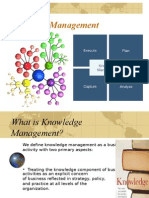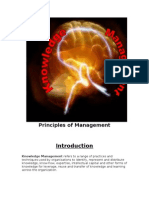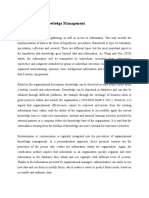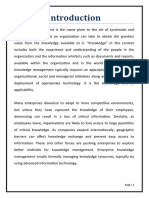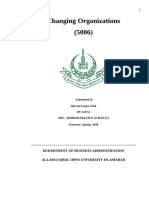Emerging Trends in Organisational Behaviour: Globalization
Uploaded by
k07011994Emerging Trends in Organisational Behaviour: Globalization
Uploaded by
k07011994Emerging trends in organisational behaviour
Organizations have witnessed a great development from the olden times
particularly in respect of structure, operations and people. There is a
considerable change in the cross-culture environment, influence of MNCs,
growth in the technical know-how and quality management which has
provided different environment in the modern organizations. Some of the
important trends observed are mentioned below:
Globalisation
Emerging employment relationships
changing workforce
Knowledge Management
Information technology and OB
Globalization
Organisation in recent days has changed the style of working and tries to
spread worldwide. Trapping new market place, new technology or
reducing cost through specialization or cheap labour are few of the
different reasons that motivates organizations to become global Moreover
the way companies integrate their business practices with other countries
has also changed. Instead of controlling the whole supply chain countries
outsource some part of it to gain advantage of specialization. Thomas
Friedman highlights this phenomenon in his book The world is flat There
are several types of organizational changes that has occurred to help
business adopt to globalisation, as the old principles no longer work in the
age of globalisation Strategic changes, technological change, change in
organizational cultural including organizational structural change and a
redesign of work tasks are some of the important one. In line with these
changes, there is strong expectation of employee to improve their
knowledge and become an integral part of successful business formula in
order to respond to the challenges brought by the global economy. In
other words it leads to formation of a learning organisation, which is
characterized by creating, gaining and transferring the knowledge, and
thus constantly modifying the organizational behaviour.
Emerging employment relationship:
Changing trends in organisations in recent years have made it utmost
important to consider some of the emerging employee relations issues
which can affect employers in the coming decade. Understanding these
issues will help management to better plan and respond to changes in the
workplace. Employer employee relationship is also showing change in the
modern era. Employers are no more autocrats and participative style of
leadership is
welcomed. Flexible working hours and increased authority motivates
employees to perform to their best. Management now welcomes upward
communication and participation of lower level employees in the decision
making process.
Changing workforce
The demographic of the workforce has changed in the recent years.. This
is due to a number of factors such as an aging population, labour
shortages and immigration. Another significant factor that has changed
the workforce is the changes in the attitudes of workers. Employers need
to adapt their recruitment, training and management processes to adapt
to changing workforce. An example of this is that where employers may
have previously looked to younger people as a source of recruits, they
may now have to broaden their view as there are currently a large number
of older people either currently employed or seeking employment. These
people may need extra training to bring their skills up to date.
New parents now want to work closer to home or from home, employers
may find that they need to make this a possible option in order to retain or
find new staff. Allowing people to work from home will also make the
employer and job more attractive to a wider range of people.
Recent days is also witnessing a shortage of skilled labour in many
sectors. Hence employers may have to take on less skilled workers initially
and develop them, rather than simply hiring experienced people. Hiring
employees from overseas also serves the purpose.
Knowledge Management:
Knowledge management is a structured activity that improves an
organizations capacity to acquire, share, and utilize knowledge for its
survival and success. Knowledge management is around us from a very
long period of time in one form or the other. The decisions we make and
the action we take both are enabled by knowledge of some type. Hence to
improve quality of these actions and decisions it is important to
understand the process of knowledge management.
Studies in knowledge management has proved an inseparable relationship
between knowledge management and organizational culture (Davenport
and Prusak,2000; Von Krogh, 2000; Nonaka and Takeuchi, 1995) Research
has also proved that organizational culture is a major barrier to leveraging
intellectual assets. They focus on four ways in which culture influences
organizational behaviours central to knowledge creation, sharing, and use.
The first is the shared assumptions about what knowledge is and which
knowledge is worth managing. Second is the relationship between
individual and organizational knowledge. Third is the context for social
interaction that determines how knowledge will be used in particular
situations. Fourth is the processes by which knowledge is created,
legitimated, and distributed in organizations.
There are three basic elements of knowledge management
1. Knowledge acquisition:- It is method of learning through
experiences, sensation or perception.
2. Knowledge sharing:- Knowledge sharing is a process through which
knowledge is shared among family, friends or any community.
3. Knowledge dissemination: It is conceptual and instrumental use of
new knowledge. Increased awareness and ability to make informed choice
among available alternatives are the outcomes of knowledge
dissemination.
Knowledge maps:- Knowledge maps guide employees to understand
what knowledge is needed to increase their efficiency and productivity
and where these knowledge are located.
Information Technology and OB
Technological change and advancement is one of the most salient factors
impacting organizations and employees today. In particular, the
prominence of information technology (IT) has grown many folds in recent
years. This innovation in IT has opened new ways for conducting business
that are different from the past. Technology has changed the nature of
work as well as the roles of employees. Managerial decision making, stress
handling, and attitude towards work have changed as an impact of
technology.It is also seen from decades that there is a normal tendency of
human being to resist to changes, making adoption of new technologies a
little difficult. It has become important for the business and management
to understand and take these issues into consideration while introducing
or implementing any new technology. Frequent sessions on change
management can help employees understand, use and adopt new
technologies easily.
You might also like
- PEGA Tutorial - PEGA Study Material - Pega Training Material87% (31)PEGA Tutorial - PEGA Study Material - Pega Training Material313 pages
- Payment Information: New Balance: $63.34 Total Minimum Payment Due: $29.00 Payment Due Date: 08/28/2021100% (2)Payment Information: New Balance: $63.34 Total Minimum Payment Due: $29.00 Payment Due Date: 08/28/20213 pages
- Emerging Trends in Managing Human Resources: Radha ShivakumarNo ratings yetEmerging Trends in Managing Human Resources: Radha Shivakumar2 pages
- The Importance of Knowledge Management Management Essa1No ratings yetThe Importance of Knowledge Management Management Essa16 pages
- Department of Management Sciences, National University of Modern LanguagesNo ratings yetDepartment of Management Sciences, National University of Modern Languages15 pages
- Technological Change and The Role of LearningNo ratings yetTechnological Change and The Role of Learning10 pages
- Knowledge Management Process and Its Impact To Employee's Work PerformanceNo ratings yetKnowledge Management Process and Its Impact To Employee's Work Performance47 pages
- Handbook for Strategic HR - Section 7: Globalization, Cross-Cultural Interaction, and Virtual Working ArrangementsFrom EverandHandbook for Strategic HR - Section 7: Globalization, Cross-Cultural Interaction, and Virtual Working ArrangementsNo ratings yet
- Bhatt.2001.Knowledge-management-in-organizations.JKMNo ratings yetBhatt.2001.Knowledge-management-in-organizations.JKM9 pages
- The Role of Knowledge Management in OrgaNo ratings yetThe Role of Knowledge Management in Orga12 pages
- Understanding The Present Day Scenario of HRM - IndiafreenotesNo ratings yetUnderstanding The Present Day Scenario of HRM - Indiafreenotes1 page
- Evolution, Basics and Importance of Knowledge ManagementNo ratings yetEvolution, Basics and Importance of Knowledge Management10 pages
- Strategic Knowledge Management and Organisational Learning67% (3)Strategic Knowledge Management and Organisational Learning16 pages
- Reinventing Talent Management: Principles and Practics for the New World of WorkFrom EverandReinventing Talent Management: Principles and Practics for the New World of WorkNo ratings yet
- Principles of Management: Knowledge Management Refers To A Range of Practices andNo ratings yetPrinciples of Management: Knowledge Management Refers To A Range of Practices and9 pages
- Knowledge Management Strategies and Emerging TechnNo ratings yetKnowledge Management Strategies and Emerging Techn5 pages
- A Brief Introduction To Organizational BehaviorNo ratings yetA Brief Introduction To Organizational Behavior28 pages
- Knowledge Management Practices in Indian Information Technology CompaniesNo ratings yetKnowledge Management Practices in Indian Information Technology Companies14 pages
- The ACE Advantage: How Smart Companies Unleash Talent for Optimal PerformanceFrom EverandThe ACE Advantage: How Smart Companies Unleash Talent for Optimal PerformanceNo ratings yet
- Explain About Strategic Management Process and Strategic ApproachesNo ratings yetExplain About Strategic Management Process and Strategic Approaches7 pages
- Organizational Behavior: A Case Study of Tata Consultancy Services: Organizational BehaviourFrom EverandOrganizational Behavior: A Case Study of Tata Consultancy Services: Organizational BehaviourNo ratings yet
- Organizational Change and Development - CuyagNo ratings yetOrganizational Change and Development - Cuyag7 pages
- What Is Organisational Behaviour? Discuss The Impact of Globalisation and Information Technology On Organisational Behaviour?No ratings yetWhat Is Organisational Behaviour? Discuss The Impact of Globalisation and Information Technology On Organisational Behaviour?8 pages
- Content:-About The Movie Litreature /content Analysis of The MovieNo ratings yetContent:-About The Movie Litreature /content Analysis of The Movie15 pages
- ASHRAE 34 - 2019 Designation and Safety Classification of RefrigerantsNo ratings yetASHRAE 34 - 2019 Designation and Safety Classification of Refrigerants18 pages
- As 2601 en E Series Valves and ManifoldsNo ratings yetAs 2601 en E Series Valves and Manifolds52 pages
- CH 7.1 Area of A Region Between 2 Curves PDF100% (1)CH 7.1 Area of A Region Between 2 Curves PDF10 pages
- Insan Sase Service Review CLASS 2012: Biology No. 2No ratings yetInsan Sase Service Review CLASS 2012: Biology No. 22 pages
- PassMark - CPU Benchmarks - List of Benchmarked CPUs 07 - 06No ratings yetPassMark - CPU Benchmarks - List of Benchmarked CPUs 07 - 06100 pages
- Econ Alive The Power To Choose 9781934534458100% (1)Econ Alive The Power To Choose 9781934534458577 pages
- Aquaculture: Farming Aquatic Animals and Plants Third Edition. Edition John S Lucas - Download the complete ebook in PDF format and read freely100% (5)Aquaculture: Farming Aquatic Animals and Plants Third Edition. Edition John S Lucas - Download the complete ebook in PDF format and read freely64 pages
- Imaan Class Center: Terminal ExaminationNo ratings yetImaan Class Center: Terminal Examination3 pages
- Alexei Leontiev - Actividy, Consciousness and Personality 00100% (1)Alexei Leontiev - Actividy, Consciousness and Personality 00128 pages
- For Intervention Detailed Lesson Plan in English Grade 9No ratings yetFor Intervention Detailed Lesson Plan in English Grade 922 pages
- Design and Fabrication of Spring Loaded FanNo ratings yetDesign and Fabrication of Spring Loaded Fan10 pages































